
As a fighter pilot with over 7,500 hours logged in over 130 types of aircraft, Bud Anderson once named his top three aircraft. The P-51, he said, because, "it's a beautiful aircraft, flies like it looks, and the Merlin engine has an incredible sound." He considers the F-86 "the fighter pilot's fighter." And the F-15, "Well, it has all the latest bells and whistles." But when comparing the aircraft of the 1940s to today technical marvels, he exclaimed, "My what I would have given for a GPS during World War II!"
Anderson served two combat tours in Europe, flying 116 missions the P-51 Mustang and was a triple ace.
During Vietnam, he commanded the 355th Tactical Fighter Wing, flying F-105s on bombing strikes against enemy supply lines.
Anderson was decorated 26 times for his military service.
FOR MORE INFORMATION ON THIS NATIONAL AVIATION HALL OF FAME ENSHRINEE, OR OTHERS PLEASE VISIT: www.nationalaviation.org/our-enshrinees

World famous for being the first man to step foot on the moon and his subsequent coining of the phrase, "One small step for man, one giant leap for mankind," Neil Armstrong had an uncanny ability for maintaining his composure in high-pressure situations. In fact, his historical moonwalk might not have taken place had it not been for his calm demeanor. Just before landing his Apollo 11's Eagle lunar module on the moon, Armstrong noticed that it was headed straight for a boulder field. He quickly switched off the vessel's auto pilot feature and assumed its manual controls. After guiding Eagle to a safe landing just seconds before it ran out of fuel, he radioed mission control and calmly stated, "Houston, Tranquility Base here, the Eagle has landed."
First man to walk on the moon July 20th, 1969.
Commanded the Gemini 8 space flight in March 1966.
An aeronautical research pilot for National Advisory Committee on Aeronautics (NACA) the forerunner of NASA, at Edwards AFB involved in the X-15 and X-20 program.
Resigned from NASA in August 1971 to become a Professor of Engineering at the University of Cincinnati.
FOR MORE INFORMATION ON THIS NATIONAL AVIATION HALL OF FAME ENSHRINEE, OR OTHERS PLEASE VISIT: www.nationalaviation.org/our-enshrinees
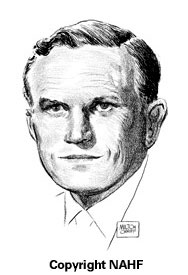
Frank Borman became a hero to people around the world when he led a team of astronauts on NASA's first moon-orbiting space mission in 1968. Four years later, while working as an executive for Eastern Airlines, Borman committed a different act of heroism. He received a phone call one evening informing him that Eastern flight 401 had disappeared off the radarscope near Florida's Everglades. Soon, Borman himself was wading through the murky swamps, helping rescue crash victims and loading survivors into rescue helicopters.
Commander of Gemini 7, which made the first rendezvous of spacecraft in orbit
Commanded Apollo 8, which became the first manned spacecraft to leave the earth's gravity and journey to the moon where they made 10 lunar orbits.
As a pilot logged over 6,000 hours of flying time.
President, CEO, and Chairman of the Board of Eastern Airlines during his 16 year tenure.
FOR MORE INFORMATION ON THIS NATIONAL AVIATION HALL OF FAME ENSHRINEE, OR OTHERS PLEASE VISIT: www.nationalaviation.org/our-enshrinees

Before Cernan left the moon on the Apollo 17 mission he remembered his daughter in a special way. "I drove the Rover about a mile away from the LM and parked it carefully so the television camera could photograph our takeoff the next day. As I dismounted, I took a moment to kneel and with a single finger, scratched [my daughter] Tracy's initials, 'TDC,' in the lunar dust, knowing those three letters would remain there undisturbed for more years than anyone could imagine."
Made three space flights: Pilot of Gemini 9, Lunar module pilot of Apollo 10, and Apollo 17 the last landing on the moon.
4,800 hours in jets and made 200 carrier landings.
Involved with the Apollo-Soyuz test project.
Inducted into the U.S. Astronaut Hall of Fame March 19th, 1993.
FOR MORE INFORMATION ON THIS NATIONAL AVIATION HALL OF FAME ENSHRINEE, OR OTHERS PLEASE VISIT: www.nationalaviation.org/our-enshrinees
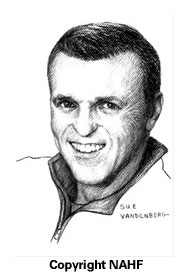
As a youngster in Abilene, Kansas, a burning desire for all things airborne seized Joe Engle. When he wasn't building model airplanes or sketching them, he would daydream about flying. Indeed, some of his best "flights of fancy" took place as he quietly gazed upward in the old Methodist Church he attended with his family. But what looked like youthful piety was actually an imaginary dogfight, taking place with dramatic dives, loops and twists between the crossbeams of the sprawling building.
In 1963 became one of the test pilots for the X-15 program.
Earned astronaut wings as X-15 pilot, becoming America's youngest astronaut at age 32.
In 1966, formally selected by NASA for the fifth group of astronaut candidates.
Commanded the second flight of the space shuttle and was the first person to ever manually fly the spacecraft from its re-entry speed of Mach 25 to a landing.
Commanded the five-man crew of STS-511, which performed the first successful in-orbit rendezvous with, and repair of, a SYSCOM IV-3 satellite.
FOR MORE INFORMATION ON THIS NATIONAL AVIATION HALL OF FAME ENSHRINEE, OR OTHERS PLEASE VISIT: www.nationalaviation.org/our-enshrinees
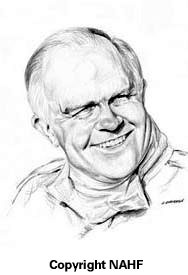
Born in Jackson, Tennessee in 1944, Steve Fossett was a precocious child. At 3 years old he taught himself how to drive a car, or rather, how to stall it repeatedly down the street using the starter button.
He joined the Boy Scouts at age 11 and worked his way up the ranks to Eagle Scout.
Keying off the scouting advancement scheme, diversity, preparedness and endurance, became fundamental elements of Steve Fossett's life of adventure.
Although a pilot since his college years, Fossett's first significant aviation endeavor was distance ballooning. He earned his balloon license in 1993 and made his first major flight in August 1994 when he and copilot Tim Cole flew across the Atlantic from Canada to Germany. His greatest goal was to fly around the world, but no manned balloon had ever flown more than 6 days or 5000 miles.
In 1995, Fossett made the first solo balloon flight across the Pacific, starting in Seoul, Korea and landing in Saskatchewan, Canada, setting an absolute world distance record of almost 5,500 miles.
Between 1996 and 2001, Fossett made five solo round-the-world attempts.
Finally, in June 2002, Fossett began his sixth attempt from Northam, Australia, flying the Bud Light Spirit of Freedom. Fourteen days and nineteen hours later he landed in Queensland, Australia, successfully completing the first round the world solo balloon flight. A flight that took a decade to achieve!
Fossett became one of 17 Zeppelin captains in the world. In October 2004 he set an absolute world speed record for airships of 71.5 miles per hour.
After flying a Falcon 10 for years, he moved up to a Cessna Citation X, in which he set transcontinental and round-the-world non-supersonic records.
Although Fossett had his mind on the "last great aviation record" Burt Rutan, the famed aircraft designer had not one, but two proposals — the first private spaceship and the solo around-the-world airplane. Fossett was more interested in the solo airplane, the GlobalFlyer.
After just 100 hours of test flights, Fossett took off from Salina, Kansas on February 28, 2005. Half way into the flight he discovered one-sixth of the fuel was missing. Fossett strategically made decisions at each point: whether he could make it to the next possible landing sites.
Riding one of the best jet stream days of the year, he continued on to Salina, landing safely on March 3. Fossett had achieved the first solo non-stop round-the-world speed record, making the journey in 67 hours, one minute and ten seconds.
Although the purpose of the Virgin Atlantic GlobalFlyer was to make the first solo around-the-world nonstop flight, Fossett contemplated a flight to establish an absolute non-stop distance record.
On the distance flight, Fossett would have to make a second Atlantic crossing at the end of his flight. Fossett left NASA Kennedy Space Center on February 8, 2006, acutely aware that the "ultimate flight" would be stretching the limits of the aircraft.
Spectators held their breath as the heavily loaded GlobalFlyer took off using almost 13,000 feet of the 15,000-foot Space Shuttle runway.
On February 11, crossing Shannon, Ireland, Fossett broke the airplane nonstop global flight distance record of 24,986 miles set by Dick Rutan and Jeanna Yeager aboard Voyager in 1986.
Fossett set a new world glider altitude record in Argentina, reaching a height of 50,727 feet in August 2006.
In total Steve Fossett held 116 world records or world firsts as well as official world records in five sports (sailboats, balloons, airplanes, gliders, and airships) before his death in 2007.
His love of flight led him to balloons. On the Spirit of Freedom, Steve Fossett became the first (and only) person to complete a solo balloon flight around the world in 2002.
He has circumnavigated the earth ballooning, sailing and flying. Long fascinated by endurance sports, he swam the English Channel, ran Alaska's famed Iditarod Dogsled Race, drove the 24 Hours of Le Mans sports car race and finished the Ironman Triathlon in Hawaii.
In his autobiography, "Chasing the Wind" (Virgin Books), Fossett talked directly about his extraordinary life in business and sport, his challenges and failures along the way, and his goals and motivations.
For his determination and commitment to blazing new trails, especially in the air, Steve Fossett earned his place in the National Aviation Hall of Fame with induction ceremonies on July 21, 2007. During Fossett's acceptance speech he told a crowd gathered at the Dayton, Ohio Convention Center "I am hoping you didn't give me this award because you think my career is complete, because I am not done."
Fossett was declared legally dead by an Illinois judge in February 2008, five months after his small plane vanished Sept. 3, 2007 while he was flying over the Nevada desert. He was 63.
"I pursue world records for the sense of personal achievement. I never tire of the satisfaction of reaching another goal. I will always find fascinating new endeavors."
FOR MORE INFORMATION ON THIS NATIONAL AVIATION HALL OF FAME ENSHRINEE, OR OTHERS PLEASE VISIT: www.nationalaviation.org/our-enshrinees
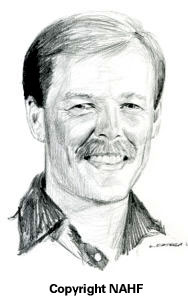
Robert Lee Gibson was born October 30, 1946, in Cooperstown, New York, but grew up in Lakewood, California. He was the second son of Paul Alexander and Margaret Rita Gibson. The family eventually included two more sons and two daughters.
Gibson fell in love with flying at an early age, as his father was a test pilot for the Civil Aeronautics Administration and later an inspector for the Federal Aviation Administration.
As a child Gibson often accompanied his father on CAA business, his father also serving as his flight instructor. Thus it was only natural Gibson would solo on his 16th birthday and receive his pilot's license the following year. In 1969 Gibson graduated from California Polytechnic State University with a bachelor of science degree in aeronautical engineering.
He entered the Navy and, soon after earning his Wings of Gold, was flying combat missions in F-4 Phantoms off the USS Coral Sea and USS Enterprise in Southeast Asia.
In 1972, Gibson graduated from Navy Fighter Weapons School, known as TOP GUN. Not surprisingly, his call sign was "Hoot," named so for the famous 1930's era cowboy-turned-movie-star of the same name.
Hoot's second combat tour was winding down when Gibson eagerly accepted the opportunity for a third — the initial carrier deployment of the Navy's new F-14 Tomcat. In all, Gibson made over 300 carrier landings while deployed to Southeast Asia.
With his final tour completed in September 1975, Gibson returned to Miramar as an F-14A instructor, then attended the U.S. Naval Test Pilot School in 1976.
Upon graduating in 1977, he was assigned to the Naval Air Test Center's Strike Aircraft Test Directorate, testing and evaluating improvements to the F-14.
In 1978, Hoot was selected for the astronaut program, joining NASA's eighth astronaut group, where he met fellow astronaut, Dr. Rhea Seddon — his future wife.
Hoot officially became an astronaut in 1979, and he and Rhea were married on May 30, 1981, one month after the first Shuttle launch. The couple would eventually have four children; Julie, Paul, Dann and Emilee.
Gibson's first trip into space was as pilot on STS-41B, launched February 3, 1984. It was the first time rendezvous sensors and computer programs were flight-tested and it was the first shuttle runway landing at the Kennedy Space Center in Florida. This mission also marked the first use of the Manned Maneuvering Unit and Manipulator Foot Restraint.
On his various space missions Gibson and his crew carried satellites, DOD payloads and science laboratories aboard Space Shuttles Challenger, Columbia, Atlantis and Endeavor.
Following the Space Shuttle Challenger catastrophe on January 28, 1986, Gibson served on the accident investigation team. He then worked on the Solid Rocket Booster Redesign Team and assisted in redesigning, testing and re-certifying the shuttle's solid rocket boosters.
Gibson also served as the Chief Astronaut and Deputy Director of Flight Crew Operations at NASA's Johnson Space Center from December 1992 to September 1994. During this time he directed the activities of 140 astronauts and 350 Flight Operations Personnel. He also managed operations for seven space launches and landings per year.
Hoot's last Shuttle mission was in June of 1995, as Commander of STS-71, the first to rendezvous and dock with the Russian space station Mir. Gibson flew five space missions in all — four as Shuttle Commander — spending over 36 days in space.
After 18 years with NASA, Gibson left in November 1996 and opened yet another chapter in his aviation life, flying as a Captain for Southwest Airlines for 10 years. Upon retirement from Southwest, he joined the Benson Space Company as Chief Operating Officer and Chief Test Pilot. By 2009 Gibson was a demonstration pilot for the Hawker Beechcraft Corporation.
Since 1984, Hoot has indulged in his passion for speed and record-setting by racing airplanes, including in a hybrid, homebuilt Cassutt aircraft. In 1998 he began racing at the Reno Air Races in either Unlimited Division warbirds or in the jet class.
In 2007 he was invited to pilot a modified Hawker Sea Fury in the Unlimited Division, clocking a blistering 437 miles per hour — the aircraft's then fastest qualifying time. Hoot continues to compete at Reno each September.
Ever the enthusiast, Hoot serves as an energetic role model and ambassador for a number of aviation causes, including the Academy of Model Aeronautics, Space Camp, and the National Aviation Heritage Invitational. He has logged 14,000 hours in 140 types of aircraft, with more on the way.
FOR MORE INFORMATION ON THIS NATIONAL AVIATION HALL OF FAME ENSHRINEE, OR OTHERS PLEASE VISIT: www.nationalaviation.org/our-enshrinees
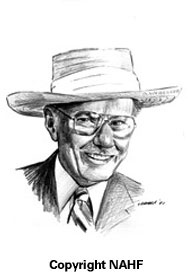
After three failed attempts to flee from his German captors, World War II fighter pilot and prisoner-of-war Bob Hoover was running out of escape options. When a staged fight among the other prisoners diverted the attention of the prison guards, the former Stalag Luft I resident hopped a barbwire fence and went looking for the refuge of Allied territory. While he didn't quite make it to Allied land on foot, Hoover did manage to find an abandoned FW-190, which he cautiously flew to the then-recently-liberated Holland.
Learned to fly at Nashville's Berry Field and taught himself aerobatics.
First World War II assignment was in Casablanca testing planes before going into combat.
Assigned to the 52nd Fighter Group in Corsica.
Flew 58 missions before being shot down and spent 16 months as a POW.
After the war, was in the Flight Evaluation Group at Wright Field, Ohio where he flew captured aircraft and the latest USAF aircraft.
Alternate pilot for the Bell X-1, Hoover flew the chase plane as close friend Chuck Yeager broke the sound barrier, October 14th, 1947.
In 1950 he began a 36 year association with North Aviation and Rockwell International.
Experimental flight tested the Navy FJ-2 jet fighter and the USAF F-86 and F-100.
Only person to serve two terms as president of the Society of Experimental Test Pilots.
Captain of the 1966 U.S. Acrobatic Team at the international competition in Moscow.
World renown aerobatic pilot and his P-51 in a main attraction at the Reno Air Races.
In 1985 established a coast-to-coast record flying a P-51 form Daytona Beach to Los Angeles in 5 hours and 20 minutes.
FOR MORE INFORMATION ON THIS NATIONAL AVIATION HALL OF FAME ENSHRINEE, OR OTHERS PLEASE VISIT: www.nationalaviation.org/our-enshrinees
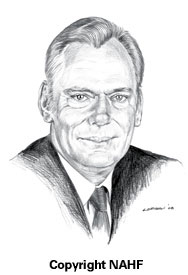
Armed with his ever present Kools and a glass of Wild Turkey, Herb Kelleher stepped down in 2008 as Southwest Airlines Chairman of the Board after 38 years. While many other airlines file for bankruptcy, Southwest Airlines has never furloughed an employee, even in the leanest of times. "You have to treat your employees like customers," Kelleher preaches. Even with the pilots of in the midst of a contract negotiation, there was no picket line only a full page ad in the USA Today thanking Mr. Kelleher for "the positively outrageous service to our Company and our pilots."
Kelleher served as President and CEO (1982 - 2001) and Executive Chairman (1978-2008).
Kelleher's colorful personality and sense of humor created a corporate culture which made Southwest employees well-known for taking themselves lightly but their jobs seriously.
Southwest began service with just three airplanes in 1971 and in 2008 the airline operated a fleet of more than 520 airplanes performing more than 3,400 flights a day.
In 2008, the airline has had 35 consecutive years of profitability.
FOR MORE INFORMATION ON THIS NATIONAL AVIATION HALL OF FAME ENSHRINEE, OR OTHERS PLEASE VISIT: www.nationalaviation.org/our-enshrinees
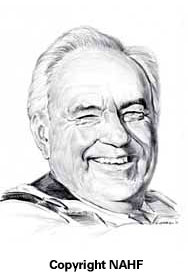
If you've seen a movie in the last four decades with spectacular aerial shots in it, chances are good that Clay Lacy helped make it happen. This 50,000-plus hour pilot and entrepreneur was a fighter pilot, a senior captain at United Airlines, a corporate jet charter business pioneer, and established a successful fixed base operation.
However, Lacy's lasting legacy may be his work as an aerial cinematographer — he has personally conducted more than 2,500 air-to-air shoots for movies, TV series, commercials and more.
Clay Lacy was born in Wichita, Kansas on August 14, 1932. He began flying at age 12. He had already logged 1,500 hours at age 19 when he joined United Airlines in the right seat of DC-3s. 40 years later, Lacy retired from United as a senior captain, having flown the Douglas prop airliners, the DC-8, DC-10, 727 and finally the 747-400. "I've been intrigued with aircraft since I was five years old and knew I wanted to be a pilot at about age seven. When I was 12, I started working at an airport-trading work time for flying time," Lacy said. "In fact, I only worked one day in my life outside of aviation-it was in a grocery and I lasted three hours."
While still a pilot at United in 1964, Lacy earned his Learjet rating and became a dealer demo pilot and salesman. Lacy leased a Learjet in 1968 and started the first executive jet charter service west of the Mississippi. In 1970, he purchased his first Learjet for Clay Lacy Aviation, establishing operations at Van Nuys Airport, where he had been based in the 1950's as a fighter pilot with the California Air Guard.
Lacy's company,Clay Lacy Aviation, soon became known as "Hollywood's private airline," carrying celebrities and executives quickly and safely around the world. Adding other aircraft types and services, he later expanded operations with a second location at Seattle, where he also did a significant amount of business filming for the aerospace industry in the region.
"I borrowed money from a bank, but no one ever put money into Clay Lacy Aviation except me; we never had a month where we were in the red," Lacy said. "We were always profitable." Lacy's experiences were not limited to simply ferrying West Coast luminaries. As a test pilot, Lacy made the first flight of the "Pregnant Guppy" — the modified Stratocruiser needed by NASA to ferry stages of the Apollo's Saturn booster. He pioneered the use on his first Learjet of the Astrovision camera system developed by Bob Nettman, revolutionizing air-to-air filming. Lacy personally flies the multiple camera-configured Lear, his memorable aerial cinematography featured in movies such as Top Gun, The Right Stuff, the IMAX Operation Red Flag: Fighter Pilot, and dozens of others.
Clay Lacy is also a veteran Reno Air Race champion, winning the Unlimited Class in 1970 at the controls of his purple P-51 Mustang. That same year he flew a DC-7 jetliner in a 1,000-mile air race, hitting 60 to 70-degree banks around the pylons and coming in sixth, out of 20 entries. Like his other racers, the jetliner bore Lacy's "Super Snoopy" race name and his regular number, 64. Lacy also holds a number of aviation world records dating back to his Air Guard service in F-86 Sabrejets. In 1988, Lacy flew 747SP Friendship One around the world in 36 hours, 54 minutes and raised more than $500,000 for children's charities. In 1995, he piloted a modified Gulfstream on a record-setting flight from Los Angeles to Paris, where the jet — equipped with newly designed winglets — then went on display at the Paris Air Show.
Lacy's significant philanthropic contributions, often made very quietly, are noted especially among the many non-profit aviation institutions, programs, filmmakers and others that have benefitted from his personal dedication to preserving and sharing America's flying heritage. Despite all his business success and accomplishments, Lacy has one overriding goal: Every day, he wants to get behind the controls and fly.
For his lifelong commitment to sharing the progress, business and joy of aviation with others, Clay Lacy is honored into the National Aviation Hall of Fame.
FOR MORE INFORMATION ON THIS NATIONAL AVIATION HALL OF FAME ENSHRINEE, OR OTHERS PLEASE VISIT: www.nationalaviation.org/our-enshrinees
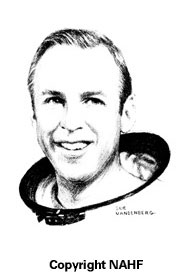
Lovell wanted badly to land on the moon, and he was glad for the chance to make a contribution to science. Lovell thought of the Apollo 13 mission patch, which read: "Ex Luna, Scientia" — From the moon, knowledge — when he christened the lunar module Aquarius, after the ancient god. But not until Lovell returned to Earth did he discover the irony in the name of the command module: Odyssey. The dictionary definition of this word was: "a long voyage with many changes of fortune."
The first astronaut to make four space flights: pilot of Gemini 7; commander of Gemini 12; Command Module Pilot of Apollo 8; and commander of Apollo 13.
As a Naval test pilot he logged over 5,000 hours flying time.
Named deputy director for science and applications at the Johnson Space Center in May 1971.
FOR MORE INFORMATION ON THIS NATIONAL AVIATION HALL OF FAME ENSHRINEE, OR OTHERS PLEASE VISIT: www.nationalaviation.org/our-enshrinees
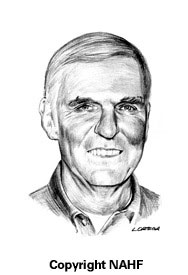
Earning his pilot's license on his 16th birthday, Dick Rutan embarked on an amazing aviation adventure that continues today. When asked how he defined success he told a crowd of students, "Success for me is when I can stand underneath the airplane at the National Air and Space Museum and say 'I built this and flew it around the world.' That, to me, is my real success." Continuing, he said, "You have to find your own pathway, even if it involves taking risks, and don't accept limitations."
As an Air Force pilot he flew 325 combat missions in the Vietnam War with 105 of them with the top-secret MISTY group.
Chief test pilot for the Rutan Aircraft Factory in Mojave, California and set numerous world speed and distance records in the Rutan Long-EZ.
Made the first nonstop, non-refueling around the world flight in the Voyager aircraft in nine days in December 1986.
FOR MORE INFORMATION ON THIS NATIONAL AVIATION HALL OF FAME ENSHRINEE, OR OTHERS PLEASE VISIT: www.nationalaviation.org/our-enshrinees
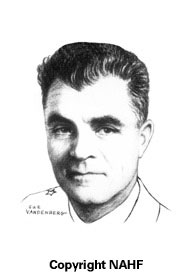
In the years since his historic atomic-bomb-dropping mission over Hiroshima, Japan, Paul Tibbets has found himself the target of extensive criticism, much of it from anti-nuclear activists. Despite all the harsh evaluations, Tibbets makes no apologies about his actions or the bomb that was instrumental in stopping World War II. He explained his reasoning in 1994 when he said, "Most writers have looked to the ashes of Hiroshima and Nagasaki to find answers for the use of these atomic weapons. The real answers lay in thousands of graves from Pearl Harbor around the world to Normandy and back again."
In 1943 after flying B-17 missions over Europe, Tibbets was assigned to test the combat capability of the B-29.
In 1944, Tibbets was assigned to the secret Manhattan Project. His responsibility was to organize and train a unit to deliver these weapons in combat operations and modify the B-29.
On August 5th, 1945, Tibbets piloted the B-29 Enola Gay to Hiroshima and dropped the world's first atomic bomb.
In 1946, Tibbets participated in the Bikini Bomb tests as a technical advisor.
He served in the Strategic Air Command, served a tour with NATO in France and was responsible for establishing the National Military Command Center in the Pentagon.
FOR MORE INFORMATION ON THIS NATIONAL AVIATION HALL OF FAME ENSHRINEE, OR OTHERS PLEASE VISIT: www.nationalaviation.org/our-enshrinees
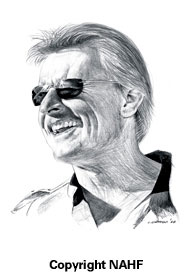
Sean Tucker says he was a "very, very fearful flyer." He knew he could have a panic attack if he even banked the plane more than 30 degrees and claims his eyes were probably closed during the power-out stall on his check ride. So Tucker faced his fear and took an aerobatic class. "When you conquer that fear, you become stronger. And I fell in love with what I was afraid of."
Tucker has won the U.S. National Advanced Aerobatic Championship, the World Aerobatic Federation Championship, the International Council of Air Shows Sword of Excellence Award, and is a four-time winner of the Championship Airshow Pilot's Association Challenge.
In 1992, he received the two most prestigious air show industry honors — the Art Scholl Memorial Showmanship Award and the Bill Barber Award for Airshow Showmanship.
In 1997, the Sean D. Tucker School of Aerobatic Flight, now known as the Tutima Academy of Aviation Safety, opened as the world's premier precision flight training school to increase the safety of pilots of all types of planes, including general aviation, military, government and commercial aviators.
In 2005, Tucker formed the four-ship aerobatic team "The Collaborators."
FOR MORE INFORMATION ON THIS NATIONAL AVIATION HALL OF FAME ENSHRINEE, OR OTHERS PLEASE VISIT: www.nationalaviation.org/our-enshrinees
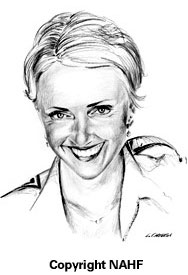
Energetic and spirited from earliest childhood, Patty Wagstaff has built a life of adventure, risk, and courage. Following her dreams even when no reward was in sight, her dedication has pushed the limits of aerobatic flight. Determined to succeed and to create her own opportunities.
Patty has earned worldwide recognition for her accomplishments as a woman, and as a pilot, flying thrilling low-level aerobatic routines in competitions and air shows before millions of spectators each year.
FOR MORE INFORMATION ON THIS NATIONAL AVIATION HALL OF FAME ENSHRINEE, OR OTHERS PLEASE VISIT: www.nationalaviation.org/our-enshrinees